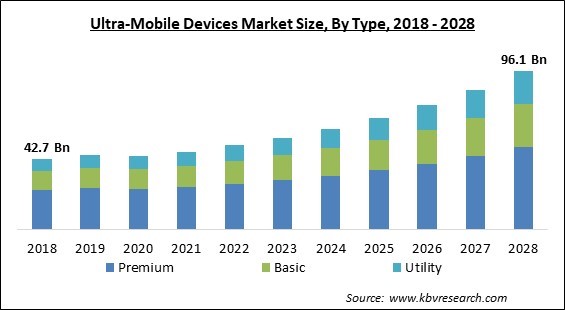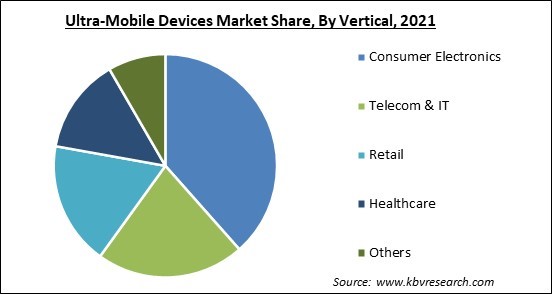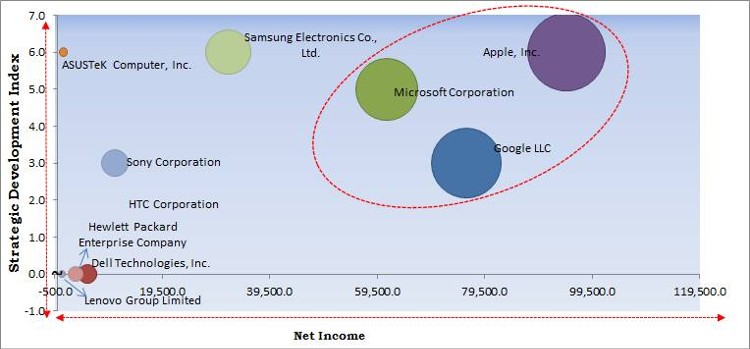
The Global Ultra-Mobile Devices Market size is expected to reach $96.1 billion by 2028, rising at a market growth of 11.2% CAGR during the forecast period.
Ultra-mobile devices can be referred to a category of compact and lightweight computing devices. These devices are designed with mid-size dimensions with a display size spanning between 7 inches to 13.9 inches. The weight of these devices usually lies under 3.5 pounds or 1.6kg. In addition, these devices are very easy to carry. Some examples of ultra-mobile devices include thin and lightweight PCs, convertibles, tablets, and smartphones.
The manner of engaging with the rest of the world has changed dramatically due to technological advancements. The user can access information and content at any time using ultra-portable internet devices. With the emerging trend of mobility, a growing number of end-users are migrating from traditional PCs and related devices to the latest and most advanced devices. These gadgets are utilized for both personal and professional reasons and are ideal for meeting the evolving demands of customers. A digital media adaptor connects a computer to a residential media system, allowing digital files and audio information to be transferred between the media and electronic devices. Surfing expenses and data consumption have increased over the world as a result of improved network coverage, innovative technologies, and a reduction in internet usage. Internet data usage has also been dominated by video and audio traffic.
More people are engaged in the utilization of these devices as the internet conglomerates, such as Amazon Prime and Netflix make their own extremely popular series. In addition, a significant number of users of these applications are ready to watch video advertising in order to continue watching shows on television, fueling demand for internet-connected gadgets like digital media adapters. Fresh video content, particularly recent films, has an advantage over other types of content. This rising demand for DMAs is beneficial since it makes it easier for them to connect to home media systems. In addition, numerous electrical gadgets and equipment are connected to the residential network in smart homes, allowing them to interact with each other. Digital audio and video-on-demand services can observe a lot of activity in the future. Digital media adaptors are increasingly being used in smart homes, which are accelerating the market's growth.

The COVID-19 pandemic had a huge impact on enterprises all across the world. Due to government-imposed lockdowns, a majority of the people was compelled to stay at home. Many individuals, businesses, and educational institutions have adopted a work-from-home policy. Due to the ongoing Covid-19 pandemic, the global import of mobile phones has increased. As online learning continues, demand for cellphones has increased significantly in emerging markets, resulting in increased mobile device manufacture during the COVID-19 Pandemic. Moreover, various industrial verticals are focusing on sophisticated technologies, such as virtual reality and augmented reality, as well as IoT across industries, to address this scenario.
Governments all over the world are encouraging people to use the internet more as a part of their digitization strategy. A significant proportion of the world's population would have access to the internet in the coming years due to increasing urbanization and technological breakthroughs. Technological advancements, increasing young working population, a reduction in bandwidth, and improvements in internet speed are all contributing to the growing internet user base. Moreover, long-term evolution, or LTE, and 3.5G communication technologies have increased the adoption of social networking sites across mobile devices since they offer faster internet connections.
Social media programs, as well as social networking sites, are accountable for a considerable amount of data generation, which would continue to grow in the future. Data generated by enterprise applications, as well as freshly generated social network data, cloud-based data, and device data, are all key corporate data sources. As an extension of the corporate information structure, this data must be accessible and made available for evaluation and decision-making. Businesses rely on social media to understand client requirements in order to achieve a competitive advantage. As a result, there is a higher demand for social business intelligence software along with collaboration tools that enable data analysis.
In the modern era, tablets are widely becoming popular in both personal and professional applications. However, the composition of these devices is fragile and can be damaged. Tablet defects can occur during the production, storage, or transportation procedures. These visual flaws can impair the product's acceptability and effectiveness among users. The body of these devices can be damaged by even a single fall. Moreover, certain devices are water-resistant. However, a majority of these devices are not water-proof and can be damaged due to any kind of fluid insertion. There are several sockets within these devices, where a short circuit can take place.

Based on Vertical, the market is segmented into Consumer Electronics, Telecom & IT, Retail, Healthcare, and Others. In 2021, the telecom and IT segment garnered a significant revenue share of the ultra-mobile devices market. The increasing growth of this segment is attributed to the rapid adoption of advanced ultra-mobile gadget systems. IT and telecom companies employ ultra-mobile device systems within their operations for a variety of purposes, including monitoring and security. Furthermore, key IT & Telecom businesses are more likely to engage in technology innovation to produce telecom solutions that are safer, network-savvy, and energy-efficient, which could give lucrative growth prospects for the IT & Telecom sector. Hence, the growth of this segment is estimated to flourish over the forecasting years.
Based on Type, the market is segmented into Premium, Basic, and Utility. In 2021, the premium segment acquired the largest revenue share of the ultra-mobile devices market. The growth of this segment is rising due to higher living standards, more technological awareness, and increased disposable income in developing as well as developed countries. Furthermore, the growth of this segment is also owing to the developments, government initiatives regarding technology development, and increased awareness about technology along with cost-effective consumer electronics.
| Report Attribute | Details |
|---|---|
| Market size value in 2021 | USD 47 Billion |
| Market size forecast in 2028 | USD 96.1 Billion |
| Base Year | 2021 |
| Historical Period | 2018 to 2020 |
| Forecast Period | 2022 to 2028 |
| Revenue Growth Rate | CAGR of 11.2% from 2022 to 2028 |
| Number of Pages | 187 |
| Number of Tables | 282 |
| Report coverage | Market Trends, Revenue Estimation and Forecast, Segmentation Analysis, Regional and Country Breakdown, Competitive Landscape, Companies Strategic Developments, Company Profiling |
| Segments covered | Type, Vertical, Region |
| Country scope | US, Canada, Mexico, Germany, UK, France, Russia, Spain, Italy, China, Japan, India, South Korea, Singapore, Malaysia, Brazil, Argentina, UAE, Saudi Arabia, South Africa, Nigeria |
| Growth Drivers |
|
| Restraints |
|
Based on Regions, the market is segmented into North America, Europe, Asia Pacific, and Latin America, Middle East & Africa. In 2021, North America witnessed the highest revenue share of the ultra-mobile devices market. Emerging technologies, lower consumer electronics prices, industrialization, as well as government initiatives are all contributing to the rapid growth of the regional market. Moreover, developing markets also provide a large potential customer base, attracting multinational manufacturers. Furthermore, Canada's IT and telecommunications industries are booming, while Mexico's electronics market is predicted to expand rapidly. These factors would play a major role in driving the growth of the regional ultra-mobile device market.
Free Valuable Insights: Global Ultra-Mobile Devices Market size to reach USD 96.1 Billion by 2028

The major strategies followed by the market participants are Product Launches. Based on the Analysis presented in the Cardinal matrix; Apple, Inc., Microsoft Corporation and Google LLC are the forerunners in the Ultra-Mobile Devices Market. Companies such as Sony Corporation, Samsung Electronics Co., Ltd., ASUSTeK Computer, Inc. are some of the key innovators in the Market.
The market research report covers the analysis of key stake holders of the market. Key companies profiled in the report include HTC Corporation, Google LLC, Dell Technologies, Inc., Sony Corporation, ASUSTeK Computer, Inc., Lenovo Group Limited, Hewlett Packard Enterprise Company (HP Development Company L.P.), Microsoft Corporation, and Samsung Electronics Co., Ltd.(Samsung Group).
By Vertical
By Type
By Geography
The ultra-mobile devices market size is projected to reach USD 96.1 billion by 2028.
The increasing availability of the internet all over the world are increasing are driving the market in coming years, however, risk of manufacturing faults in these device growth of the market.
HTC Corporation, Google LLC, Dell Technologies, Inc., Sony Corporation, ASUSTeK Computer, Inc., Lenovo Group Limited, Hewlett Packard Enterprise Company (HP Development Company L.P.), Microsoft Corporation, and Samsung Electronics Co., Ltd.(Samsung Group).
Yes, Covid-19 pandemic, the global import of mobile phones has increased. As online learning continues, demand for cellphones has increased significantly in emerging markets, resulting in increased mobile device manufacture during the Pandemic.
The Consumer Electronics segment acquired maximum revenue share in the Global Ultra-Mobile Devices Market by Vertical in 2021, thereby, achieving a market value of $34.1 billion by 2028.
The North America market dominated the Global Ultra-Mobile Devices Market by Region in 2021, and would continue to be a dominant market till 2028.
Our team of dedicated experts can provide you with attractive expansion opportunities for your business.
